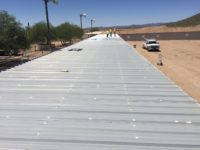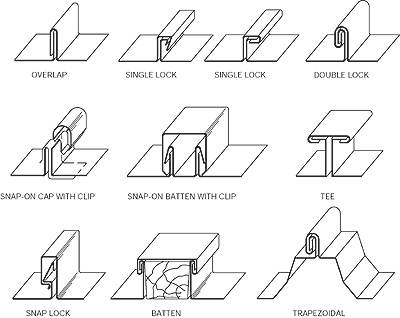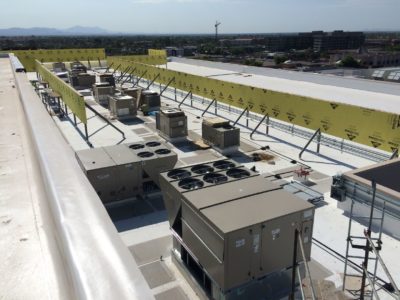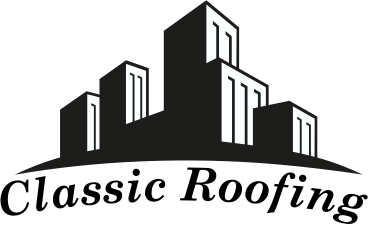Built-up roof (BUR) Membranes
Sometimes refer to as “tar and gravel”, for its appearance, BUR roof systems have been in use for over a century. BUR systems are made of up layers of bitumen and reinforcing elements known as roofing felts or ply sheets. These layers alternate to create the roof membrane.
of bitumen and reinforcing elements known as roofing felts or ply sheets. These layers alternate to create the roof membrane.
The bitumen used in BUR systems is comprised of asphalt, coal tar, or cold adhesive. Asphalt is more commonly used than coal tar but both have to be heated at an optimum temperature for application. Cold-applied adhesive are comprised of solvent-based asphalts that don’t have to be heated before application.
Metal Panel Roof for low slope
Structural metal panels is the only type used for low-slope roofing. Structural metal panels are hydrostatic properties. Majority of these roof systems resist passage of water at joints with the ability to use sealants at the seams.
resist passage of water at joints with the ability to use sealants at the seams.
There are two types of roof deck or substrate used in this system: fully-closed spaced decking for full support, or spaced structural supports like purlins. Spaced structural supports are the most common. If fully-closed spaced deck is present, it is recommended an underlayment be used before panels are installed.
Metal Roof Systems for steep slope
There are three typed of panels used for steep-slope roofing systems; architectural panel, structural metal panel, and metal shingle/shingle panels. Architectural panels have water-sheading properties that are warranted for steep-slope applications. Unlike structural metal panels, architectural panel seams are not water tight. This is not needed since the water moved rapidly down the slope. Metal shingles and shingle panels main use is for aesthetic reasons. They are manufactured to look like traditional asphalt, wood, tile or slate shingles. These are commonly used for historical building whereby the historical aesthetic is retained while using a more resistant and modern material.
One of the most important aspects of metal panels are the seams. There are many types of seams.

Picture Credit NARC
Thermoplastic Membranes
Thermoplastic materials can be softened when heated and harden when cooled. This is very important in standing up to the elements and temperature changes. Thermoplastic membranes are either heat or solvent welded.
The five common types of thermoplastic membranes are:
- Polyvinyl Chloride – PVC
- Thermoplastic Olefin –TPO
- Chlorinated Polyethylene – CPE
- PVC Alloys or Compounded Thermoplastics
- Copolymer Alloy –CPA
- Ethylene Interpolymer (EIP)
- Nitrile Alloys (NBP)
- Tripolymer (TPA)
The most commonly used thermoplastic membrane are PVC and TPO
PVC
PVC sheets are reinforced with polyester or glass fiber mats or scrim. PVC sheets contain plasticizers and stabilizers and additives. Sheet widths range from 6 to 12 feet wide and are typically 45-90 mils thick. Seams are sealed with heat or chemical welding.
TPO
TPO sheets are a mixture of polypropylene and ethylene propylene polymers. Usually polyester is used for reinforcement. TPO sheets contain flame retardants and UV absorbers. Sheet widths range from 6 to 12 feet wide and are typically 40-100 mils thick. Seems are heat welded with hot air.
PVC and TPO are installed fully adhered, mechanically attached or ballasted.


